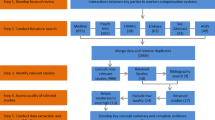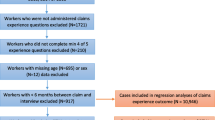Abstract
Introduction: Health care providers (HCPs) play a central role in workers’ compensation systems. In most systems, they are involved in the legitimization of work-related injury, are required to provide information to workers’ compensation boards about the nature and extent of the injury, give recommendations about return-to-work capability and provide treatment for injury or illness. This study identifies problems that occur at the interface between the health care system, injured workers, and workers’ compensation boards (WCBs) that may complicate and extend workers’ compensation claims and the mechanisms that underlie the development of these problems. Methods: Interviews were sought with injured workers, peer helpers and service providers from a variety of geographic locations in order to get a broad picture of return to work problems and concerns. This analysis includes data from total of 34 interviews with injured workers who had long term and complicated claims. Interviews were also conducted with 14 peer helpers and 21 service providers. Results: We identified four domains related to injured workers’ interface with the health care system that played a key role in complicating and prolonging compensation claims. These problems, related to health care access, conflicting or imperfect medical knowledge, limited understanding of compensation system requirements and confusion about decision-making authority, resulted in frustration, financial difficulties and mental health problems for injured workers. Conclusion: Recommendations are made about how compensation system parties can find better ways to serve injured worker health care needs and facilitate a smooth relationship between the compensation board and HCPs.
Similar content being viewed by others
Notes
In Ontario a physician, chiropractor or physiotherapist can be an injured worker’s primary health care provider. In their study examining the effect of health care provider communication on return to work, Kosny et al. [25] found that 75% of studied workers had a physician as their main health care provider.
After this study was completed the terminology changed at the Ontario Workplace Safety and Insurance Board. The term ‘adjudicator’ was replaced by ‘case manager’. In this paper we have used the term ‘adjudicator’ for congruence with the participants’ own language in the quotes.
All names are pseudonyms.
References
Workplace Safety and Insurance Board. Healthcare practitioners: working with the WSIB [cited 2010 Sept 10]. Available from: http://www.wsib.on.ca/wsib/wsibsite.nsf/public/HealthReporting. 2007.
Beardwood B, Kirsh B, Clark N. Victims twice over: perceptions and experiences of injured workers. Qual Health Res. 2005;15(1):30–48.
Dasinger LK, Krause N, Thompson PJ, Brand RJ, Rudolph L. Doctor proactive communication, return-to-work recommendation, and duration of disability after a workers’ compensation low back injury. J Occup Environ Med. 2001;43(6):515–25.
Deyo RA. The role of the primary care physician in reducing work absenteeism and costs due to back pain. Occup Med State Art Rev. 1988;3(1):17–30.
Kosny A, Franche RL, Pole J, Krause N, Cote P, Mustard C. Early healthcare provider communication with patients and their workplace following a lost-time claim for an occupational musculoskeletal injury. J Occup Rehabil. 2006;16(1):27–39.
Nordin M, Cedraschi C, Skovron ML. Patient-health care provider relationship in patients with non-specific low back pain: a review of some problem situations. Baillieres Clin Rheumatol. 1998;12(1):75–92.
Laerum E, Indahl A, Sture SJ. What is “the good back-consultation”? A combined qualitative and quantitative study of chronic low back pain patients’ interaction with and perceptions of consultations with specialists. J Rehabil Med. 2006;38(4):255–62.
Reynolds CA, Wagner SL, Harder HG. Physician-stakeholder collaboration in disability management: a Canadian perspective on guidelines and expectations. Disab Rehabil. 2006;28(15):955–63.
Russell G, Brown JB, Stewart M. Managing injured workers: family physicians’ experiences. Can Fam Physician. 2005;51:78–9.
Schweigert MK, McNeil D, Doupe L. Treating physicians’s perceptions of barriers to return to work of their patients in southern Ontario. Occup Med. 2004;54(6):425–9.
Lax MB. Occupational medicine: toward a worker/patient empowerment approach to occupational illness. Int J Health Sci. 2002;32(3):515–49.
Lippel K, Lefebvre MC, Schmidt C, Caron J. Managing Claims or caring for claimants: effects on the compensation process on the health of injured workers. UQAM Service aux collectivites: Universite du Quebec a Montreal; 2007.
MacEachen E, Kosny A, Ferrier S. Unexpected barriers in return to work: lessons learned from injured worker peer support groups. Work. 2007;29(2):155–64.
Richie J, Lewis J. Qualitative research practice. London: Sage Publications; 2003.
MacEachen E, Kosny A, Ferrier S, Chambers L. The “toxic dose” of system problems: why some injured workers don’t return to work as expected. J Occup Rehab. 2010;20(3):349–56.
Strauss A, Corbin J. Basics of qualitative research. Techniques and procedures for developing grounded theory. 2nd ed. Thousand Oaks, California: Sage Publications, Inc.; 1998.
Ontario Medical Association. OMA position paper. The role of the primary care physician in timely return to work. Ont Med Rev. 2009;76(3):23–38.
Mayer RS. The physician’s role in workers’ compensation. J Back Musculoskeletal Rehabil. 1998;10:81–8.
Mootz RD, Franklin GM, Stoner WH. Strategies for preventing chronic disability in injured workers. Top Clin Chiropr. 1999;6(2):13–25.
Pransky G, Katz JN, Benjamin K, Himmelstein J. Improving the physician role in evaluating work ability and managing disability: a survey of primary care practitioners. Disab Rehabil. 2002;24(16):867–74.
Talmage JB. Failure to communicate: how terminology and forms confuse the work ability/disability evaluation process. J Insur Med. 2007;39(3):192–8.
Lotters F, Franche RL, Hogg-Johnson S, Burdorf A, Pole JD. The prognostic value of depressive symptoms, fear-avoidance, and self-efficacy for duration of lost-time benefits in workers with musculoskeletal disorders. Occup Environ Med. 2006;63(12):794–801.
Friedman PJ. Predictors of work disability in work-related upper-extremity disorders. JOEM. 1997;39(4):339–43.
Theodossiou I. Effects of low-pay and unemployment on psychological well-being: a logistic regression approach. J Health Econ. 1998;17:85–104.
Kosny A, Franche RL, Pole J, Krause N, Cote P, Mustard C. Early healthcare provider communication with patients and their workplace following a lost-time claim for an occupational musculoskeletal injury. J Occup Rehabil. 2006;16(1):27–39.
Acknowledgments
We would like to acknowledge the Workplace Safety and Insurance Board Research Advisory Council for funding support.
Author information
Authors and Affiliations
Corresponding author
Rights and permissions
About this article
Cite this article
Kosny, A., MacEachen, E., Ferrier, S. et al. The Role of Health Care Providers in Long Term and Complicated Workers’ Compensation Claims. J Occup Rehabil 21, 582–590 (2011). https://doi.org/10.1007/s10926-011-9307-3
Published:
Issue Date:
DOI: https://doi.org/10.1007/s10926-011-9307-3




